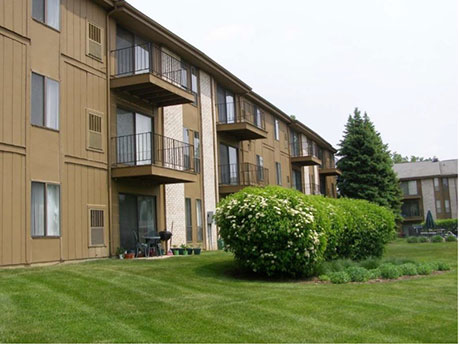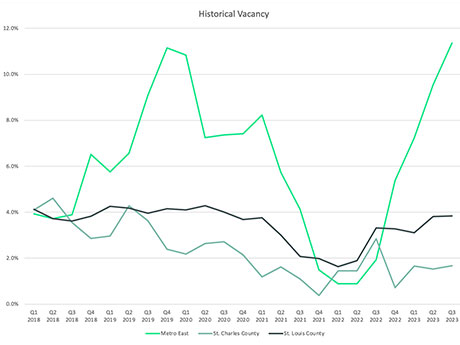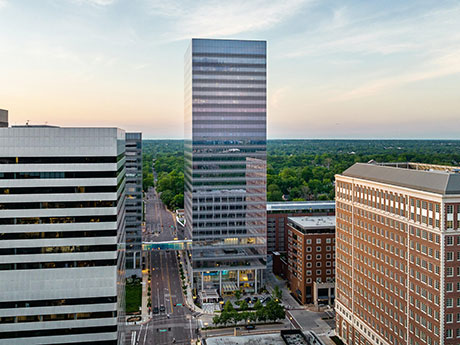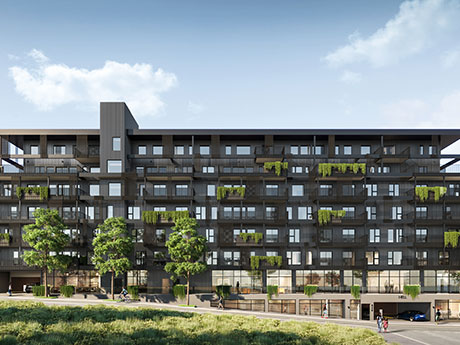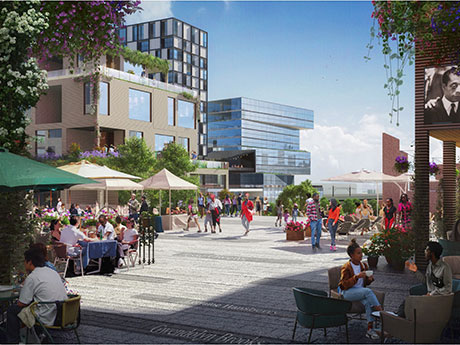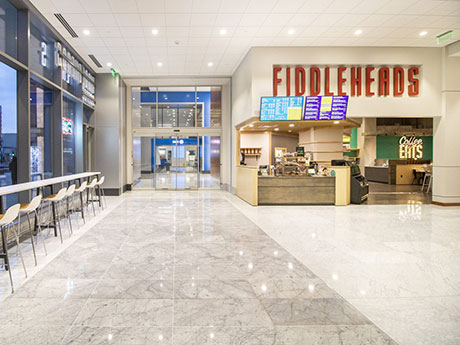By Adam Ferguson, Bernard Financial Group If 2022 was a lesson in how rapidly things can change in commercial real estate, 2023 was an exercise in adaptation for both borrowers and lenders alike. Detroit is no stranger to change or adaptation. From becoming the Motor City and growing into the country’s fourth-largest city during the first half of the 20th century to a renaissance in the 2010s after several decades of bumps and bruises, Detroit continues to add to its storied history. With billions of dollars of investment within the city limits and growing suburban sectors, Detroit’s multifamily market is making significant advancements by adding fresh developments to a market where 38 percent of multifamily inventory is over 50 years old. While certainly not the only catalyst, low interest rates help to spur development. Lower cost of capital is especially impactful in markets like Detroit where building costs are high and rents are low compared with other major markets. Southeast Michigan averaged over 3,800 units of multifamily housing building permits issued per year over the past decade. Compare that to an average of 988 from the decade prior and one can discern the growth in demand for multifamily housing financing …
Midwest Market Reports
By Matt Hrubes and Joshua Allen, CBRE St. Louis is located at the crossroads of the U.S. at the intersection of I-55 (north/south) and I-70 (east/west), making it a prime location for industrial real estate users and developers alike. The Greater St. Louis area is separated by the Mississippi and Missouri rivers, giving it a natural division of industrial submarkets. Each side of the Mississippi River tells a different story as it relates to industrial real estate. Metro East To the east of the Mississippi River is the Metro East industrial submarket, which was the first in the area to offer real estate tax abatement, resulting in larger industrial developments ranging in size from 500,000 square feet to over 1 million square feet. Over the last decade, this area has seen some of the largest speculative developments in the region from national developers such as Panattoni, NorthPoint and Exeter, as well as local developers like TriStar. Absorption had been at all-time highs with groups like Amazon, World Wide Technology, Geodis, Sam’s Club, P&G and Tesla leasing space as buildings were being completed. That is, until 2023 when a wave of space became available either through sublease, speculative development completions or …
By Nick Fiquette, Sansone Group Lingering effects of COVID-19 In the aftermath of the global pandemic, the St. Louis real estate market finds itself at a crossroads, continuing to see the persistent impacts of COVID-19. Corporate strategies are evolving as companies evaluate their real estate footprints to accommodate the changing work environment and desires of employees. As lease expirations loom, businesses are engaged in a delicate dance of evaluating their physical space needs. The pendulum of work-from-home policies, initially adopted to streamline footprints, appears to be swinging back. Recently, Edward Jones listed a 227,000-square-foot Class A building that it owns on the market for lease and is planning on occupying it instead. This example could serve as a positive indicator for the future of the office market. The market is transforming as companies look to accommodate employee demands, prioritizing safe, walkable areas and amenity-rich buildings. This shift is particularly evident in the struggle faced by commodity real estate, as businesses increasingly gravitate toward locations that contribute positively to the employee experience. As a result, investors are remaining cautious about purchasing office assets due to surging interest rates and uncertainties surrounding the future of the office market. Corporate giants reevaluate real …
By Max Helgeson, CBRE As the national real estate landscape undergoes transformative shifts, Kansas City has emerged as one of the region’s most attractive multifamily markets. There are a myriad of attributes making Kansas City an unrivaled destination to deploy capital in the heart of the Midwest. Here are six key areas that propel the market to the forefront of real estate investors’ considerations. Economic anchors, diversification Kansas City has one of the nation’s most diverse economies with no sector comprising more than 15 percent of overall employment. A national leader of several durable industries provides unmatched economic stability and significant risk mitigation for investors. Moreover, the metro’s strategic location in the heart of the U.S. and strong transportation infrastructure make it a favored logistical hub for corporations across the world. Finally, the market is a base for startups and entrepreneurs drawn to the area’s abundant talent pool and competitive office space rates. Strategic infrastructure, connectivity Infrastructure is a cornerstone of Kansas City’s rise to prominence. The city’s strategic network of highways, interstates, railways, fiber networks and a major airport not only facilitates connectivity but positions it as a hub for commerce. This strategic infrastructure acts as a magnet, pulling …
By John Faur, Newmark Zimmer The Kansas City industrial real estate market has been on a historical run since 2020 with over 40 million square feet of inventory added in that time frame. This run of new construction has catapulted Kansas City to the 15th largest industrial market in the country by square footage, despite only being the 31st largest MSA by population. During most of this period, the strong market dynamics which exist in Kansas City, such as strategic highway infrastructure, a centralized location, four Class-1 railroads, availability of bulk land sites and an active development community, were further amplified by the low-interest rate climate and record levels of tenant activity. The continued high pace of speculative industrial construction starts in 2022 positioned 2023 to experience a healthy amount of new deliveries, with almost 8 million square feet of speculative industrial space delivering to the market. While the financial markets presented opportunity during this run of growth, continuous rate hikes in 2023 created challenges that resulted in a significant decrease in year-over-year speculative construction starts (3.5 million square feet of speculative construction has occurred year to date in 2023 as compared with more than 13 million square feet in …
By John Bogdasarian, Promanas At a time when the multifamily marketplace is experiencing some turbulence after an extended period of strong growth, some developers, owners and investors are rethinking, repositioning and reworking their approach to a commercial real estate sector that has historically been one of the most reliable investments and dependable asset classes. Current market conditions, however, are not as favorable. A report by The Motley Fool this summer highlighted a 21 percent decline in apartment value. Overbuilding has saturated some markets, contributing to an increase in vacancy rates to around 7 percent and helping push rent growth down to 0.8 percent. In conjunction with persistently high interest rates and increasing delinquency issues with renters, the result is that building a traditional apartment product is a very tricky proposition. Even though the apartment market is somewhat dysfunctional at the moment, there are still plenty of opportunities in multifamily. For thought leaders and forward-thinking commercial real estate investors and professionals, the key is to understand the market, be flexible in your development and investment strategies, and be able to execute an approach that does work in the current marketplace. For those looking to maximize multifamily returns in 2024, there are …
By J. Byron Brazier Equitable development is a knotty concept. In theory, development equity sounds easy and essential. In practice, it’s not clearly defined and not easily sustainable — economically, socially or politically. Equitable development is generally seen as an approach that revitalizes and empowers disinvested communities by meeting residents’ wants and needs, diminishing disparities and spurring economic growth, ensuring residents benefit from such growth and creating conditions for people to live healthy and happy lives. That definition is accurate but incomplete. Equitable development has multiple meanings, some less intuitive than others. Chicago lawyer Danielle Meltzer Cassel says there are three ways to define development equity. The first is the one above, which is the direct model of equitable development. This model rectifies inequality through what development directly produces, such as affordable housing in areas where there’s little or no such housing, good jobs for people who are unemployed or underemployed, greater access to quality healthcare and education, and other resources that allow communities to thrive. There are two other definitions, the indirect model and what Cassel calls the procedural model of equitable development. The indirect model involves real estate developments that do not directly benefit disinvested communities, such as …
By Cecilia Hyun, Esq. Taxpayers usually appeal property tax assessments by proving a market value different from the assessor’s finding, but they should not overlook constitutional guarantees of uniform and equal taxation. As an ad valorem tax, real property taxes are charged on the value of the underlying real estate, usually measured as fair market value. In many states, taxpayers can demonstrate their property’s market value with a recent, arm’s-length sale price or by independent appraisal evidence. Two potential concerns emerge for taxpayers in an assessment appeal centered on market value: the declining reliability of data in volatile and rapidly changing markets, and the trailing nature of market data used by assessors. Those data issues can skew the mass appraisal techniques tax assessors often use, including comparisons to sales of similar properties, when assessing real property. Volatility, rapid change Commercial property data can lose relevancy with surprising speed in a volatile market. For example, office properties continue to bear the consequences of increased remote work and occupants’ shrinking footprints since the pandemic. Many office properties with mortgages maturing in 2023 have lost half or more of their previously underwritten asset values. Badge swipes tracked by Kastle Systems show an average …
By David Pudlosky and Patrick Savoie, JLL Milwaukee remains a strong office market with leasing activity showing no sign of slowing. Post-pandemic, companies took a fresh look at their workplace strategies to adjust to hybrid working environments, and many rightsized their overall square footage while adding significant amenities and attractions that provide a rewarding office experience for returning workers. Despite a smaller footprint, tenants are seeking updated, highly amenitized spaces in Class A buildings. While amenities have always been a focus for landlords, the buildings that stand out today are the ones that focus on quality amenities over quantity. For example, today’s tenant will likely not be as interested in a building lounge unless it has comfortable seating, a café, strong Wi-Fi and more. To be relevant to tenants, amenities must be high end and culture focused. We’ve seen companies like Milwaukee Tool, Fiserv, Komatsu Mining Corp. and Northwestern Mutual invest in their downtown office spaces and make commitments to bring more employees downtown, and we expect this trend to continue. Building owners can learn from what Class A building landlords are doing to drive leasing activity, and learn how investing in quality, amenity-driven spaces will likely bring in new …
By Drew Miller, CBRE Despite some level of macroeconomic uncertainty, the fundamentals of the industrial real estate market in West Michigan remain solid. While the overall number of tenants in the market has recently declined slightly, the demand for space from local companies and tenants new to the market is still outpacing supply. Nationally, the overall industrial vacancy rate finished the second quarter of 2023 at 3.7 percent, 30 basis points higher than the previous quarter but 100 basis points lower than the 10-year average. Comparatively, the West Michigan industrial market, of approximately 170 million square feet, ended the second quarter with an availability rate of less than 3 percent. The combination of a diverse economy, robust infrastructure and a conservative approach to development all factor into the continued strength of the region. Grand Rapids, the second-largest city in Michigan, and West Michigan at large are blessed with a well-balanced and diverse economy led by office furniture, automotive suppliers, aerospace, food processing, e-commerce and advanced manufacturing companies. The area is home to many of the leading office furniture and related design companies, including MillerKnoll, Haworth and Steelcase, all headquartered in West Michigan, with many of their manufacturing and suppliers …


